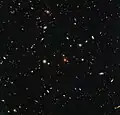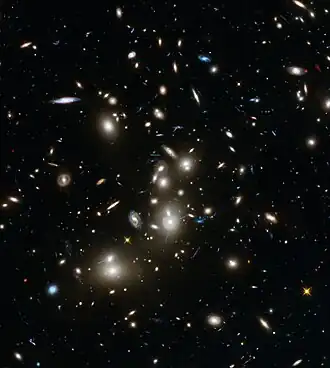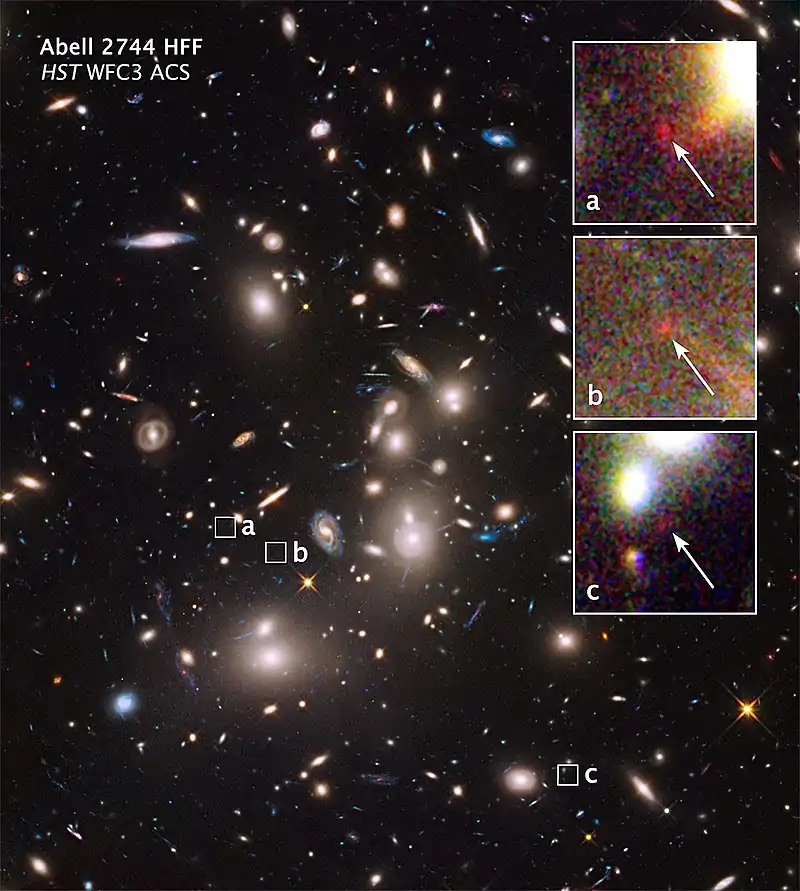Abell 2744
Abell 2744, nicknamed Pandora's Cluster, is a giant galaxy cluster resulting from the simultaneous pile-up of at least four separate, smaller galaxy clusters that took place over a span of 350 million years, and is located approximately 4 billion light years from Earth.[1] The galaxies in the cluster make up less than five percent of its mass.[1] The gas (around 20 percent) is so hot that it shines only in X-rays.[1] Dark matter makes up around 75 percent of the cluster's mass.[1]
| Abell 2744 | |
|---|---|
 Abell 2744, nicknamed Pandora's Cluster. The galaxies in the cluster make up less than five percent of its mass. The gas (around 20 percent) is so hot that it shines only in X-rays (coloured red in this image). The distribution of invisible dark matter (making up around 75 percent of the cluster's mass) is coloured here in blue. | |
| Observation data (Epoch J2000) | |
| Constellation(s) | Sculptor |
| Right ascension | 00h 14m 19.51s [1] |
| Declination | −30° 23′ 19.18″ [1] |
| Richness class | 3[2] |
| Bautz–Morgan classification | III[2] |
| Redshift | 0.30800[3] |
| Distance | 1,221 Mpc (3,982 Mly) h−1 0.705 [3] |
| X-ray flux | (5.805 ± 4.7%)×10−13 erg s−1 cm−2 (0.1–2.4 keV) [3] |
| Other designations | |
| Pandora's Cluster | |
This cluster also shows a radio halo along with several other Abell clusters. It has a strong central halo, along with an extended tail, which could either be relic radiation, or an extension of the central halo.[4]
Renato Dupke, a member of the team that discovered the Cluster, explained the origin of the name in an interview: "We nicknamed it ‘Pandora's Cluster’ because so many different and strange phenomena were unleashed by the collision."[5]
Gallery
 Abell 2744 parallel field observed as part of the Frontier Fields programme.[6]
Abell 2744 parallel field observed as part of the Frontier Fields programme.[6] Abell 2744 intracluster light artificially colored in blue. This light come from galaxies that were torn apart long ago by the cluster's gravitational forces. [7]
Abell 2744 intracluster light artificially colored in blue. This light come from galaxies that were torn apart long ago by the cluster's gravitational forces. [7]
 Abell 2744 galaxy cluster - extremely distant galaxies revealed by gravitational lensing (16 October 2014).[9]
Abell 2744 galaxy cluster - extremely distant galaxies revealed by gravitational lensing (16 October 2014).[9]_Uncover_program.png.webp) Pandora's Cluster observed by James Webb Space Telescope's NIRCam as part of UNCOVER program (15 February 2023).[10]
Pandora's Cluster observed by James Webb Space Telescope's NIRCam as part of UNCOVER program (15 February 2023).[10].jpeg.webp) The James Webb Space Telescope's infrared vision explores behind Pandora's Cluster.[11]
The James Webb Space Telescope's infrared vision explores behind Pandora's Cluster.[11]
References
- "Pandora's Cluster – Clash of the Titans". NASA.
- Abell, George O.; Corwin, Harold G. Jr.; Olowin, Ronald P. (May 1989). "A catalog of rich clusters of galaxies" (PDF). Astrophysical Journal Supplement Series. 70 (May 1989): 1–138. Bibcode:1989ApJS...70....1A. doi:10.1086/191333. ISSN 0067-0049. Retrieved 13 March 2012.
- "NED results for object ABELL 2744". NASA/IPAC Extragalactic Database (NED). Retrieved 17 March 2012.
- Govoni, F.; Ensslin, T. A.; Feretti, L.; Giovannini, G. (23 January 2001). "A Comparison of Radio and X-Ray Morphologies of Four Clusters of Galaxies Containing Radio Halos". Astronomy & Astrophysics. 369 (2): 441–449. arXiv:astro-ph/0101418. Bibcode:2001A&A...369..441G. doi:10.1051/0004-6361:20010115. S2CID 18507943.
- Renato Dupke quoted at Pandora's Cluster - a galactic crash investigation Press release of 22 June 2011
- "Swimming in Sculptor". Retrieved 7 March 2016.
- "Hubble sees ghost light from dead galaxies in galaxy cluster Abell 2744". www.spacetelescope.org. ESA/Hubble. Retrieved 4 November 2014.
- Clavin, Whitney; Jenkins, Ann; Villard, Ray (7 January 2014). "NASA's Hubble and Spitzer Team up to Probe Faraway Galaxies". NASA. Retrieved 8 January 2014.
- Chou, Felecia; Weaver, Donna (16 October 2014). "RELEASE 14-283 - NASA's Hubble Finds Extremely Distant Galaxy through Cosmic Magnifying Glass". NASA. Retrieved 17 October 2014.
- Ramsay, Leah; Pulliam, Christine. "NASA's Webb Uncovers New Details in Pandora's Cluster". Space Telescope Science Institute. NASA/ESA/CSA. Retrieved 15 February 2023.
- "Webb Draws Back Curtain On Universe's Early Galaxies". October 18, 2023.
External links
- Image in the visible spectra -Hubble spacetelescope(Lars Holm Nielsen et al) retrieved 20/09/2011
- Video simulation of the merging events that created Abell 2744- Hubble space telescope (Lars Holm Nielsen et al) retrieved 20/09/2011